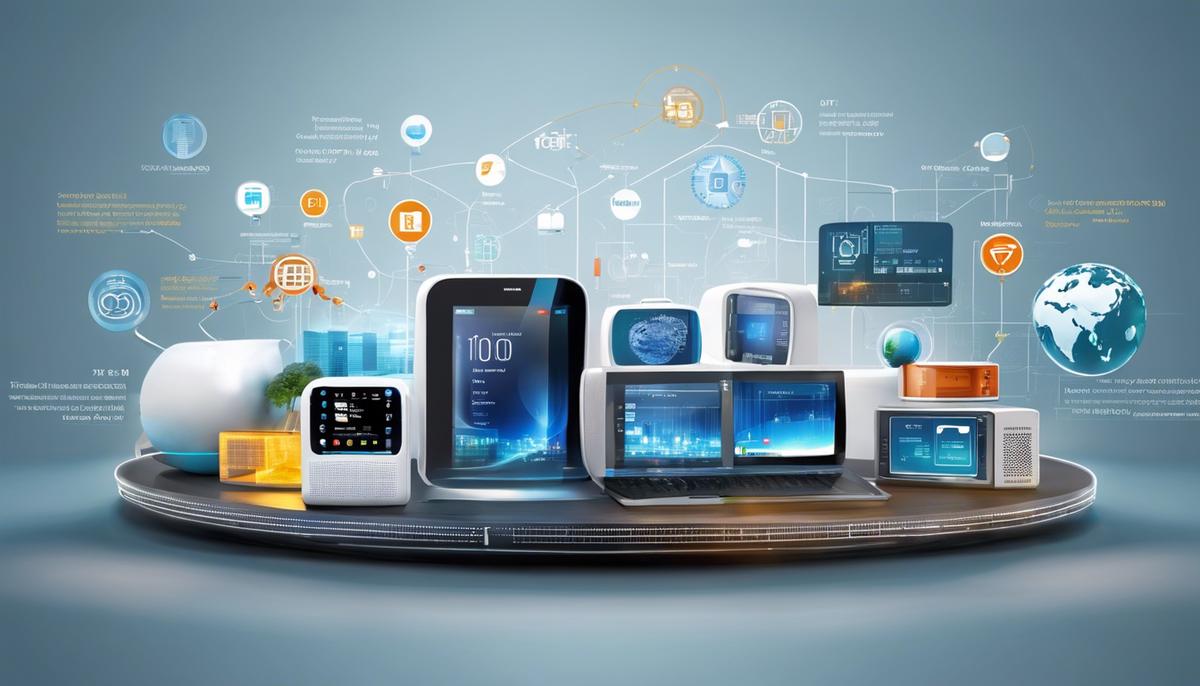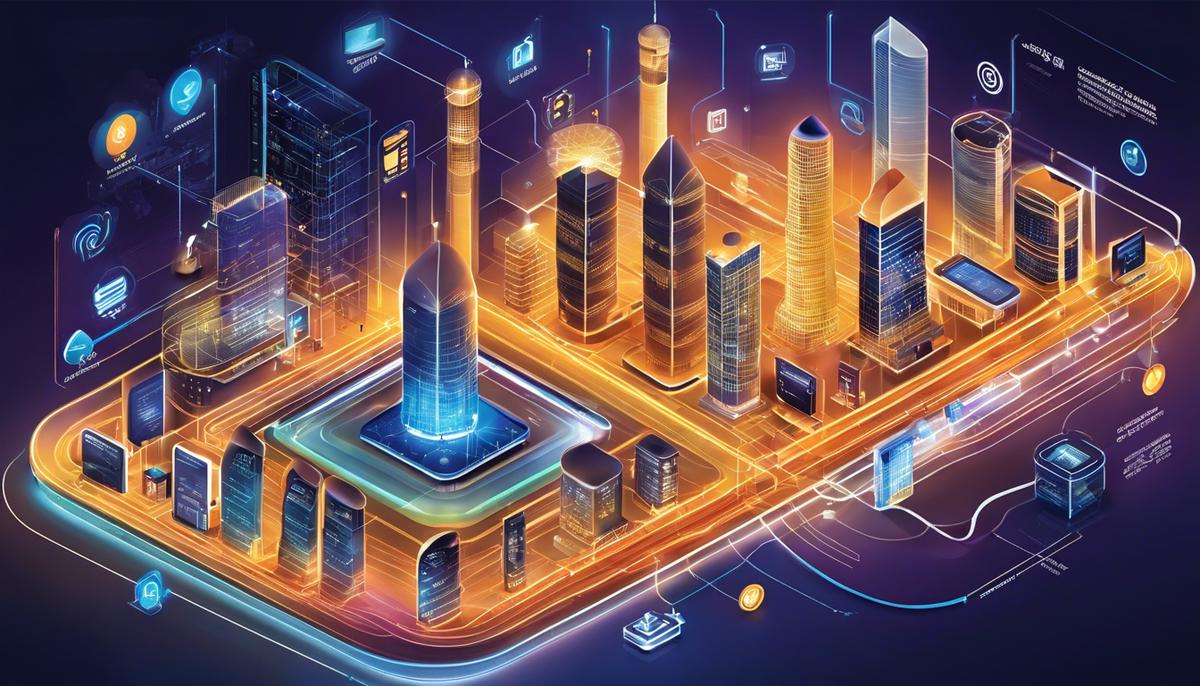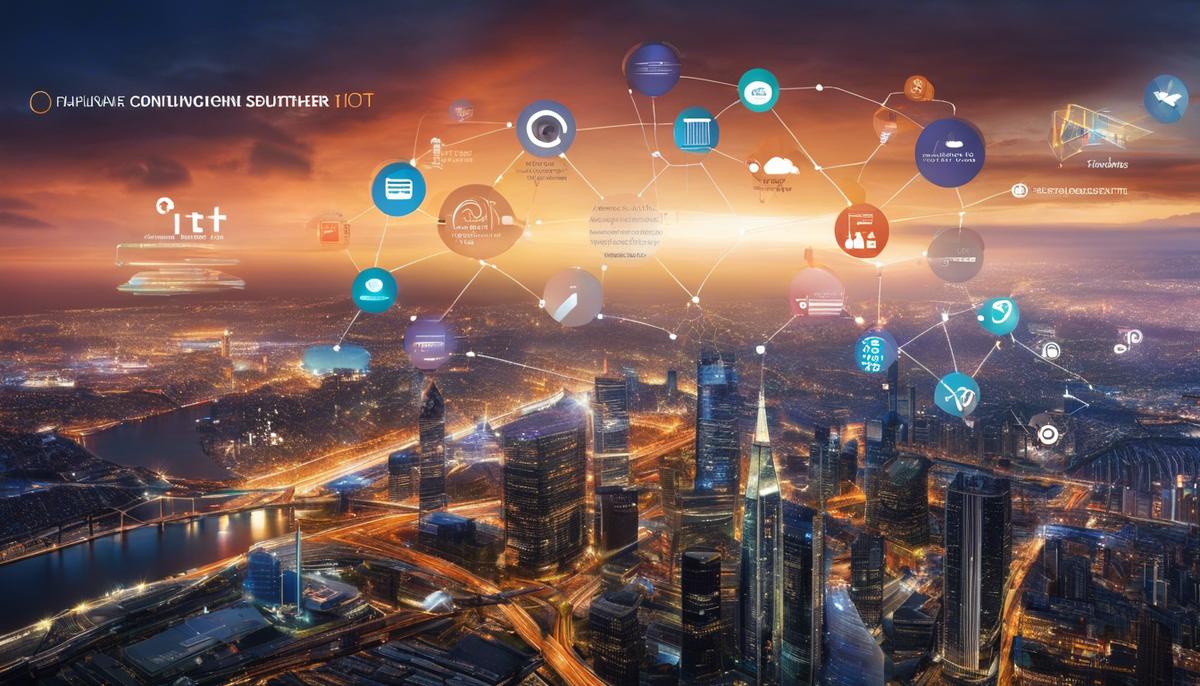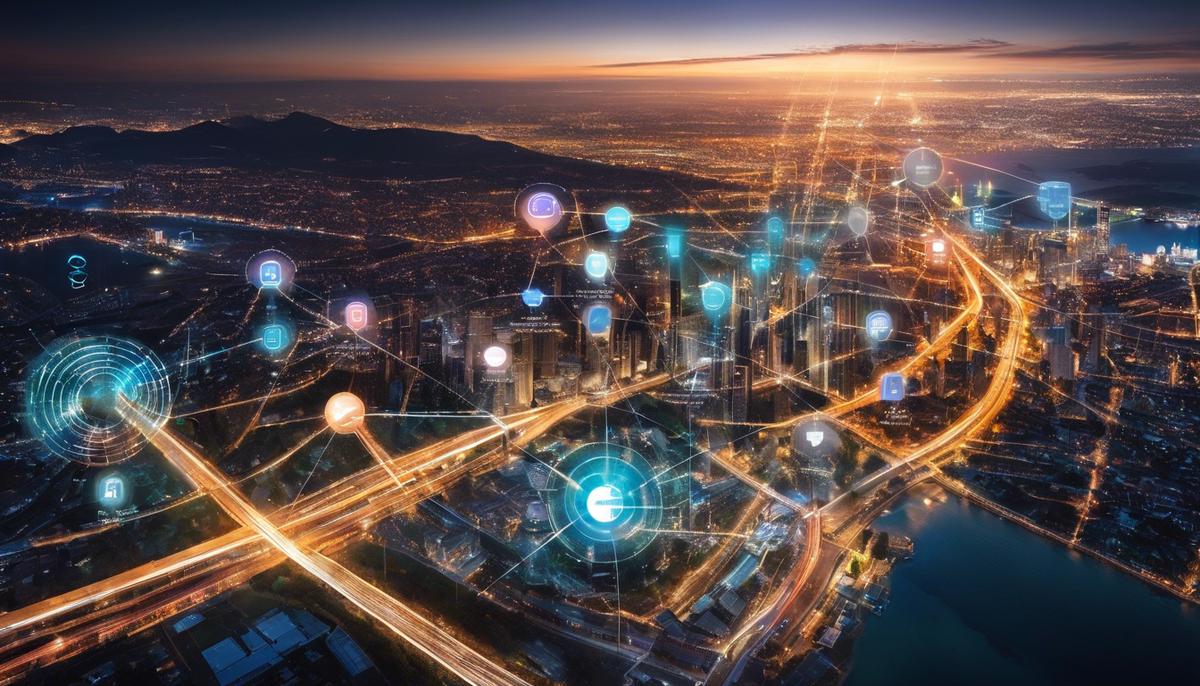As the world steadily careens towards the brink of a technological revolution, one concept that consistently echoes in the corridors of innovation is the Internet of Things (IoT). IoT is not just a buzzword; it signifies a radical transformation redefining the way we interact with our environment, both physical and digital. This paper dives deep into the intricacies of IoT, retracing its historical footsteps, and shedding light on its remarkably intricate architecture. Supported by concrete instances of its application across various industries, the paper also grapples with the challenges that accompany its implementation, yet also shines a light on the solutions that keep it afloat. Lastly, it gazes towards the horizon, envisioning the promising potentials that IoT holds for the future of global civilization.
Understanding IoT: Overview & Evolution
The Evolution of IoT: Unfolding the Revolution in Technology
An exciting revolution is occurring in the world of technology, primarily driven by IoT or the Internet of Things. For the uninitiated, this refers to the network of physical devices like cars, home appliances, and others embedded with sensors, software, and network connectivity, enabling these objects to connect, interact and exchange information. In the era of digital interconnection, understanding IoT is not just a must for tech enthusiasts but has become an imperative for everyone living in the 21st century.
In essence, the Internet of Things is about harnessing the data from ‘things’ by connecting them to the internet. It may sound simple, but the innovation and dexterity it has brought to our fingertips is nothing short of game-changing.
Marking Back to the Beginnings
The seeds of IoT were sown in the late 1990s and early 2000s with the advent of RFID (Radio Frequency Identification) technology and pervasive computing. However, it wasn’t until 2008-2009, an epoch in the evolution of technology, that IoT term received its official baptism. This was also the year when, shockingly, the number of ‘things’ connected to the internet surpassed the number of people.
Navigating the Progress Over Years
Like every tech novelty, IoT matured over the years, expanding its scope and significance in our lives. Early IoT was primarily focused on individual convenience – turning on lights using a smartphone, a refrigerator that alerts you when you’re out of milk, and so forth. While these examples of smart homes and consumer IoT still hold relevance, the concept has evolved to encompass Industrial Internet of Things (IIoT). IIoT, with its vast network of connected devices in industries and manufacturing, heralds a new wave of optimization and efficiency on an industrial scale.
The Era of Advanced IoT
Today, IoT stands at the threshold of an advanced era, empowered by complementary technologies like Machine Learning and Artificial Intelligence. The integration of such technologies with IoT has fostered predictability and real-time action, making it a blue-eyed boy in sectors such as healthcare, agriculture, transportation, etc. We now live in an era where smart wearables can monitor our health and provide actionable insights, smart cities manage resources efficiently, and smart agriculture optimizes yield using sensor data.
What Lies Ahead?
Predicting the exact future of IoT may be as much of a challenge as trying to predict the future of technology in general. However, with the advent of 5G technology, the expansion of the Internet of Things is almost inevitable. Enhanced speed and lower latency offered by 5G alongside developing technologies like Edge computing will further open new avenues for IoT’s potential. With these ecosystems in place, IoT promises a future where everything from streetlights to jet engines could be a part of the IoT landscape.
In conclusion, the Internet of Things is a vivid testament to the ability of technology to transform lives and industries. In its evolution from a niche technology to a mainstream tool, IoT exemplifies a growing trend where interconnectivity becomes a way of life, manifesting in ways as varied as our imaginations allow. A subject of curiosity, fascination, and practical utility, the voyage of IoT has just begun. Beware, for this journey is fast, thrilling, and transformative – the IoT evolution is one you don’t want to miss!

IoT Architecture & Its Components
Moving past the inception, evolution and the transformative effect of IoT, lets delve into the heart of the matter – the key components of IoT and its architectural design.
Arduino boards, Raspberry Pi and other embedded systems are the star players when we dive into IoT components. These microcontrollers, an integral part of the hardware section, enable data processing and conversion of raw inputs into readable data bits. They are the direct contact points that interact with the surrounding environment, acquiring useful data via various built-in tools like temperature sensors, proximity sensors and many more.
Supplementing this are IoT gateways, tasked with the pivotal role of serving as intermediaries. A vital component, gateways exist to weed out unnecessary data, transferring only the most valuable to their destination, thereby ensuring efficient network utilization. They are also heavily encrypted, providing a secure channel to avoid data breaches. Gateways also act as protocol translators, maintaining smooth communication between devices operating on different protocols.
To bridge the physical and digital worlds, we have Actuators – devices capable of transforming electric signals into meaningful actions like turning on an LED light or triggering a system shutdown.
Moving onto the software aspect, it is divided into three crucial areas: IoT platforms, Data Analytics, and Networking. IoT platforms such as Microsoft Azure, Google Cloud IoT, and Amazon Web Services (AWS) IoT, provide the much-needed infrastructure for managing IoT functionalities, managing assets, and securing IoT applications. Moving up a notch is the Data Analytics component, primarily utilized for processing and analyzing the huge data chunks derived from IoT. It draws meaningful conclusions, aiding in decision-making processes. Networking, the bond that holds all these components together, ensures a smooth flow of data and commands between all IoT elements.
With the key components known, understanding the architectural design of IoT becomes innate. First, at the base level are the sensor devices, actuators, embedded systems, and so much more; the physical objects linked together in the IoT. Above this, we find the Gateway and Network layer tasked with data forwarding and routing the incoming data from various devices towards the processing units. Then comes the Management services layer that processes and analyses this data. Last but certainly not the least is the Application Layer that interacts with the end-users, providing an interface for interaction with the IoT environment.
To summarize, the architecture builds upon the strength of the components – a symbiotic relationship that coexists to not only bridge the gap between the digital and physical entities but one that is continually redefining the trajectory of industries and lives. This intricate fabric of devices, software and network interweaved together constitutes the comprehensive framework of IoT.
So, while the past and present have seen IoT bring a technological revolution, the future seems brighter than ever. With advancements like 5G amplifying its impact, a new era beckons where IoT will be more than just a term; it will be a way of life.

Applications of IoT in Various Industries
From retail to insurance, manufacturing to energy, every industry is feeling the influence of the Internet of Things (IoT). Each sector is experimenting, innovating, and exploring ways to harness its potential. By connecting devices and implementing data analytics, IoT is opening doors to new opportunities, pushing businesses to evolve and even transform their models.
The retail sector, for instance, has made use of IoT to revolutionize the shopping experience. IoT-powered smart mirrors change the dynamic of trying on clothes. They not only save time for shoppers but can also suggest accessories, add-on items, or alternative sizes or colors right there in the fitting room, leading to a potential increase in sales. Store inventory management has also seen a shift, with smart shelves automatically updating inventory status, alerting staff to restock shelves, and providing much-needed valuable data for supply chain optimization.
Manufacturers have used IoT to create smart factories where connected devices and automated systems improve efficiency, reduce downtime, and allow for predictive maintenance. Sensors on the factory floor, when connected to the cloud, can provide real-time performance data and even predict potential problems before they occur. This virtually eliminates the risk of machinery failure and ensures optimal efficiency at all times – a game changer for the industry.
The insurance sector is another industry that has been dramatically affected by IoT. With connected sensors, insurance companies can monitor the driving habits of a car owner, leading to more accurate risk assessments and premium calculations. Smart home devices like connected thermostats and alarm systems can provide similar insights for home insurers, ultimately leading to a shift from reactive to proactive risk management.
Energy has also felt the imprint of IoT. Smart grids help streamline energy distribution, enabling energy providers to optimize production and reduce waste. Additionally, smart meters provide real-time usage data to consumers, helping them monitor and reduce unnecessary consumption, and even take advantage of cheaper tariffs at less busy times.
Lastly, the transportation and logistics industry has greatly benefited from IoT. Vehicle tracking and fleet management solutions have made logistics significantly more efficient. Real-time monitoring data not only help manage the itineraries and routes but also enable predictive maintenance, which in turn increases vehicle lifespan and reduces costs.
In every sector, IoT systems are empowering businesses with insights and efficiencies that were unimaginable just a few years ago. Today, we stand at a fascinating precipice. Amid growing network connectivity, one can’t help but look forward to what the continued evolution of IoT will bring. The Internet of Things, it’s not just hype; it’s a reality and its impacts are profound and far-reaching. Brace yourselves, because IoT is just heating up.
Embrace the change. Embrace the IoT.

Challenges and Solutions in Implementing IoT
The Internet of Things (IoT) is revolutionizing sectors from manufacturing to healthcare, yet it isn’t without challenges. A few significant hurdles that technologists must overcome include security concerns, vast data management, and interoperability incompatibility among others. But, as always, challenges just offer a unique opportunity to innovate.
Undeniably, security is a primary concern in the IoT sphere. Keeping the mammoth web of interconnected devices secure from potential breaches is a considerable challenge. Still, creative solutions like blockchain technology, advanced encryption, and improved user authentication promise a more secure IoT environment. Blockchain, for instance, provides a decentralized structure, reducing a single point of failure. Furthermore, continuous upskilling of cybersecurity professionals and high-tech intrusion detection systems can further solidify IoT networks against cyber threats.
The amount of data generated by interconnected devices is colossal, making its management and analysis no mean feat. However, technologies like cloud computing and edge computing are coming to the rescue. Cloud computing provides vast storage and processing capabilities, while edge computing allows data processing closer to the data source, reducing latency and bandwidth use, crucial for real-time applications. Moreover, AI and Machine Learning can crunch these vast data sets, yielding actionable insights.
Interoperability poses a significant hurdle as IoT devices from various manufacturers must communicate seamlessly. The secret lies in framing robust standardizations and IoT protocols with an inclusive approach. To bridge this gap, efforts are already underway by global organizations like IoTivity and AllJoyn to create universal open standards.
The high cost of IoT implementation, particularly for small businesses, is a sticking point. Striving for cost-effective IoT solutions can be driven by competitive pricing of IoT components, open-source software, and improved scalability provisions.
Lastly, the power consumption of IoT devices is concerning given the sheer number of connections. Energy-efficient designs, use of renewable energy sources, and development of energy-harvesting technologies are potential fixes for this issue.
Each of these challenges presents a unique conundrum that awaits an innovative solution. The one constant, however, is the transformative potential of IoT. As with technology, adaptation and evolution are inherent aspects of growth. With the right blend of regulation, innovation, and perseverance, each of these challenges can turn into the next wave of opportunity for the IoT world.

Future Perspectives of IoT
Challenges of IoT and Smart City Implementation
The evolution of IoT technology isn’t without its hurdles. Alongside its potential to revolutionize multiple industries comes significant challenges that need tackling for a streamlined IoT deployment.
Cities around the world are integrating IoT technology into their infrastructure, transitioning into ‘smart cities.’ However, the deployment of IoT devices on such a scale brings with it new challenges. These include harnessing the data generated, ensuring continued connectivity and robustness of IoT devices, and, most importantly, addressing the security and privacy concerns inherent in data-intensive applications.
The sheer volume of data that IoT devices generate is mind-boggling. It becomes an arduous task to manage, store, process, and analyze this data accurately and efficiently.
Cloud computing offers the scalability required for this data explosion, by providing on-demand pooled computing resources. More recently, edge computing has emerged as a viable complement to the cloud, bringing computation and data storage closer to the data source, reducing latency and protecting data in case of a network failure. It’s all about leveraging the best of both worlds to manage and analyze IoT data optimally.
Moreover, interoperability issues, one of the significant challenges with IoT, arise due to the lack of universal open standards. As such, there’s a pressing need for global partnerships aimed at creating universally accepted standard protocols to address IoT interoperability issues.
IoT’s transformative power is also met with the high cost of implementation. Firms are tackling this issue by incorporating a phased approach, introducing IoT operations gradually while continuously evaluating return-on-investment against initial projections.
Another critical concern is power consumption. With billions of IoT devices expected to be online in the years to come, we will see a dramatic rise in energy consumption. To circumvent this, developers are exploring energy-harvesting technologies and designing algorithms that optimize power use.
Lastly, the most significant challenge comes in the form of security concerns owing to the massive volume of data IoT devices collect. Blockchain technology, encryption techniques, and stringent user authentication protocols are being deployed in an attempt to enhance data security.
Despite these issues, IoT’s transformative potential cannot be understated. With each challenge comes an opportunity for adaptation, innovation, and evolution. Being on the brink of a 5G era, IoT is primed to redefine technology as we know it, making our lives easier, businesses more efficient, and societies smarter. With more people acknowledging IoT’s potential, its opportunities will likely outweigh the challenges as technology continues to evolve.

As the exploration of IoT comes full circle, it is apparent that this transformative technology is more than just an ephemeral trend. It is a powerful force driving unprecedented changes in multiple industries, delivering improved efficiencies, enacting cost-saving measures and proffering solutions to complex problems. Nonetheless, the path to its complete integration is strewn with challenges – cybersecurity threats, technical limitations, compatibility issues – all of which require proactive and innovative solutions. Despite these obstacles, the future of IoT shines with limitless possibilities. As we venture into this future, the pace of innovation will only quicken, and the adoption of IoT will become a de facto standard for progress. Thus, the mastery of IoT and a deep understanding of its prospects and perils will be essential for anyone looking to thrive in a world increasingly steeped in technology.
